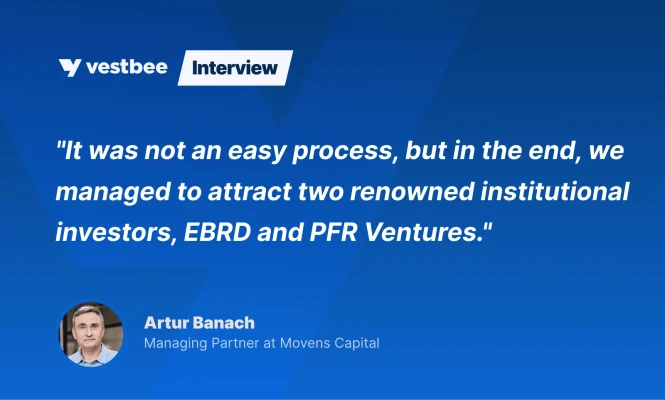Movens Capital recently launched its €60 million Fund II, marking a strategic shift toward growth-stage investments with a strong emphasis on AI. In this interview, Managing Partner Artur Banach discusses Fund I’s performance, including the successful 2023 exit of Fenige, and explains how the fund navigated a challenging fundraising environment to attract institutional investors like EBRD and PFR Ventures. He also shares insights into the evolving Central and Eastern European tech ecosystem and Movens Capital’s vision for supporting startups scaling globally.
What’s the current status of Fund I? You exited Fenige in 2023 — have there been any other exits? How does the net IRR look today, and how would you assess the portfolio's real performance so far?
By early 2022, we anticipated that raising funds for technology startups in Central and Eastern Europe would become significantly more challenging. This forecast proved accurate, with transaction volumes in the region declining by approximately 70% over the following two years. Anticipating these market shifts, we proactively guided our portfolio companies to secure additional funding rounds, effectively extending their financial runway. This strategic approach paid off — our portfolio collectively raised around €130 million (including the recently announced €20 million round of Trasti, the largest in Polish insurtech history), representing a tenfold increase over the initial investment rounds led by Movens Capital.
These additional funds allowed most of our companies to prioritize stable revenue growth and operational efficiency. A substantial number have reached breakeven or achieved a strong cash flow position, providing them the flexibility to decide independently on future financing rounds. Notably, around half of the Fund I portfolio companies have experienced their strongest growth in the US and other English-speaking markets, reinforcing their global competitiveness. While Fenige's exit has been our most prominent liquidity event so far, the overall health of the portfolio positions us optimally for further successful exits in the future. We don't disclose our net IRR. However, all indicators currently point toward returns aligned with our (and our LPs) initial expectations.
In our 2023 interview, you shared plans to launch a €60 million Fund II, with the first close expected in H1 2024. What happened? Why did it take longer than anticipated? What were the main challenges in closing the fund?
Indeed, it took us longer than planned to launch the fund. This is mainly because it is a difficult time for fundraising, although the establishment of the first fund in Luxembourg is certainly more complicated and time-consuming than we had anticipated. It was not an easy process, but in the end we managed to attract two renowned institutional investors, EBRD (this is currently their only investment in Poland in an early-stage VC fund) and PFR Ventures, as well as 80 excellent private investors, more than half of whom come from the world of technology companies.
Even without the second closing of the fund, we are one of the five largest Polish VC funds. We see how many great companies are struggling to finance their growth, and we are ready to address this gap.
What made you decide to go beyond early-stage and include later-stage rounds in Fund II? Was that driven by lessons from Fund I, or more by current market dynamics?
Our decision to expand into later-stage investments in Fund II was influenced by insights gained from Fund I as well as current market dynamics. We recognized significant opportunities to continue supporting our most successful companies through later-stage rounds, enabling them to scale internationally. If you analyze Dealroom's data, there are more than 6,000 companies in CEE that have received VC funding in the last five years. Many of them are thriving but still have huge problems raising finance.
The ability to deploy larger amounts (up to €4-5 million per company) helps us build deeper, long-term relationships and assist companies in reaching higher maturity stages efficiently.
Movens plans to invest across enterprise software, climate tech, fintech, healthcare, e-commerce infrastructure, and future-of-work, with a strong emphasis on AI. How do you prioritize these sectors, and are there any emerging niches within them you’re especially excited about for Fund II?
We will continue to be a generalist fund, but AI remains a strategic priority, given our extensive experience in this area over the past decade. We are convinced that many AI enterprises will be established in our region to take advantage of the revolution introduced by multi-agent architecture. This is already confirmed by our first investments (not yet announced), but also by the quality of the companies which are entering our funnel.
In a landscape oversaturated with “AI-first” startups, how do you cut through the noise and evaluate truly defensible, scalable companies in this space?
To identify genuinely defensible AI startups, we focus on tangible barriers to entry and clear competitive advantages. This includes assessing the quality and uniqueness of their AI models or architecture, but what's even more important is the proprietary nature of their data, robustness of technical teams (publications, domain expertise, talent caliber), and strong early validation from international customers. Startups must also demonstrate the potential for rapid and sustainable scaling — ideally tripling annual revenues — combined with excellent retention metrics and positive unit economics.
With Fund II, how do you plan to compete with larger pan-European growth investors? What does your ideal Series A+ target look like?
This may indeed need to be clarified. At a later stage, we assume investing in Series A or companies that already have at least 3-5M ARR and are close to BEP, even if their growth rate is already less than 100% YoY. We are therefore not in direct competition with Western European and American VCs, who invest much bigger tickets in bigger companies. On the contrary, we are addressing a huge gap in the market.
Our advantage lies in our hands-on, entrepreneurial approach, combined with deep domain expertise and extensive global VC relationships. Ideal Series A+ targets are companies already demonstrating robust traction internationally, possessing scalable unit economics (LTV/CAC > 4, low burn multiple, CAC payback < 6 months), and potential for reaching at least EUR 50 million ARR within five to seven years.
What is the best way for startups to reach Movens Capital if they’re interested in funding or support?
The best way to reach us is through direct introductions from mutual connections, reaching out via our website at movenscapital.com, or connecting with our team members directly on LinkedIn. We remain highly accessible and proactive in engaging with ambitious founders from the CEE region.






